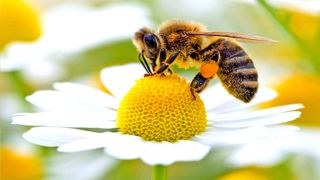Making a bee-line for new camera technology
The hive mind works out a better way to process color

The way humans perceive colour varies with the time of day, or rather the amount of sunlight falling on an object. And, unfortunately, current technology is as limited in color perception as the human eye.
An interdisciplinary team of researchers in Melbourne, Australia, has discovered that for bees, however, color perception is constant, no matter the light conditions, so they can get to the right flower.
If we could replicate the workings of bee vision, it would be possible to eliminate the problems associated with color vision in cameras, drones and robots.
Project coordinator Associate Professor Adrian Dyer said, "For a digital system like a camera or robot, the color of objects often change. Currently this problem is dealt with by assuming the world is, on average, grey. This means it's difficult to identify the true color of ripe fruit or mineral rich sands, limiting outdoor color imaging solutions by drones, for example."
Where physics and biology meet
Bees have three extra eyes (or ocelii) at the top of their heads which can sense the color of ambient light, thanks to a couple of color receptors. These ocelli are separate to the pair of front-facing compound eyes which detect flower colors.
Lead scientist Dr Jair Garcia from Melbourne’s RMIT University suggests that the sensing of the color of light by the ocelli “could allow a brain to discount the naturally colored illumination which would otherwise confuse color perception. But for this to be true the information from the ocelli would have to be integrated with colors seen by the compound eyes."
Dr Yu-Shan Hung at the University of Melbourne corroborated Garcia’s statement by mapping the neural pathways from the ocelli and showed neurons did pass data on to the color processing parts of the bee brain.
Get daily insight, inspiration and deals in your inbox
Get the hottest deals available in your inbox plus news, reviews, opinion, analysis and more from the TechRadar team.
Color revolution
The team has discovered the mathematical principles behind a honeybee’s complicated vision, which can then be programmed into a computer. This could completely revolutionise the camera systems in our smartphones, improving drone footage and making robots see better.
"We're using bio-inspired solutions from nature to tackle key problems in visual perception. This discovery on color constancy can be implemented into imaging systems to enable accurate color interpretation,” Dyer added.
The results of this research have been published in the journal 'Proceedings of the National Academy of Sciences' (PNAS)

Sharmishta is TechRadar's APAC Managing Editor and loves all things photography, something she discovered while chasing monkeys in the wilds of India (she studied to be a primatologist but has since left monkey business behind). While she's happiest with a camera in her hand, she's also an avid reader and has become a passionate proponent of ereaders, having appeared on Singaporean radio to talk about the convenience of these underrated devices. When she's not testing camera kits or the latest in e-paper tablets, she's discovering the joys and foibles of smart home gizmos. She's also the Australian Managing Editor of Digital Camera World and, if that wasn't enough, she contributes to T3 and Tom's Guide, while also working on two of Future's photography print magazines Down Under.
Most Popular

